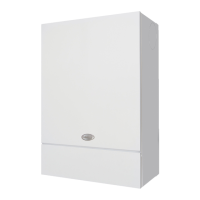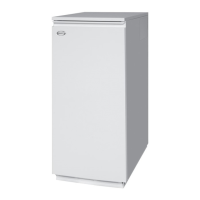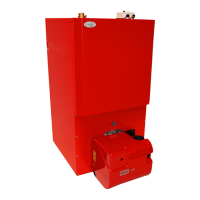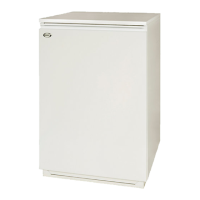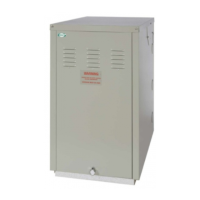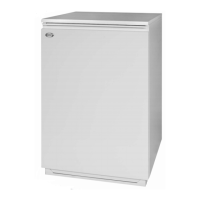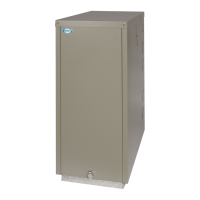Page 38 Section 11: Servicing
11 SERVICING
To ensure safe and ecient operation it is essential that a Grant
Combi boiler is serviced at regular intervals of no longer than 12
months.
Servicing and replacement of parts must only be carried out by a
suitably qualied engineer.
! CAUTION !
Details of every service should be entered in the Service
Log, in the Boiler Handbook.
This information may be required to validate the Grant
extended guarantee.
! WARNING !
Before starting any work on the boiler or fuel supply,
please read the Health and Safety information given in
Section 15 of these Instructions.
11.1 CHECKS BEFORE SERVICING
The following sequence of checks should be made before starting
any servicing work:
1. Check the ue terminal and ensure it is not blocked or
damaged.
2. Run the boiler and check the operation of its controls.
3. Ensure that all water system connections and ttings are
sound. Remake any joints and check the tightness of any
ttings that may be leaking.
4. Allow the boiler and system to cool down.
5. The boiler is part of a sealed central heating system, check
the system pressure, check the operation of the pressure
relief valve and check the expansion vessel air charge. Refer
to Section 7.
6. Rell, vent and re-pressurise the system as necessary. Refer
to Section 7.
7. Check that the ventilation holes in the front casing door are
clear of obstructions. See Section 9.
8. Remove any sludge/water from the fuel tank by opening the
sludge valve at the lower end of the tank (if tted).
9. Ensure that all fuel system connections and ttings are
sound. Remake any joints and check the tightness of any
ttings that may be leaking.
10. With the fuel supply valve (at the oil tank) closed, clean/
replace the lter element and clean the lter bowl.
! WARNING !
Before servicing, set the boiler ON/OFF switch to OFF,
isolate the electricity supply and close the fuel supply
valve.
The data label on the inside of the case side panel will indicate
the fuel used and the nozzle tted.
11.2 DISMANTLING PRIOR TO
SERVICING
The procedure for dismantling the boiler is as follows:
1. Remove the front casing door by turning the handle and
pulling forward at the bottom.
2. Remove the four screws retaining the top casing panel and
carefully lift it o, taking care not to damage the insulation.
! NOTE !
The top panel has been designed to provide a slight fall
away from the side positioned against a wall. Please refer
to Figure 4-1 for further details.
3. Carefully lift up the expansion vessel and remove it from
the boiler. Place it on the oor, taking care not to strain the
exible pipe.
4. Unscrew and remove the two xing screws and remove the
red cover from the burner.
5. Remove the burner xing nut (located at the top of the
mounting ange) and withdraw the burner from the boiler. If
required, disconnect the exible oil line(s), using a suitable
container to prevent any oil spillage.
6. Check or replace the exible fuel supply hose, as follows:
• Braided exible fuel supply hoses (as supplied with the
boiler) should be replaced annually, i.e. when the boiler
is serviced.
• Long-life hoses should be inspected annually. If in doubt
replace the hose(s). In any event, these hoses must be
replaced every ve years.
! NOTE !
With a two-pipe oil supply there will be two exible hoses
connected to the burner. Identify (mark if necessary) which
is the inlet and return if they are to be disconnected.
11.3 CLEANING THE BOILER
The procedure for cleaning the boiler is as follows:
1. Remove the nuts and washers securing the front cleaning
door and withdraw the door. Take care - it is heavy.
2. Remove the baes as shown in Figure 11-1, Figure 11-2 and
Figure 11-3.
3. Remove all deposits from the bae plates and all the boiler
internal surfaces using a sti brush and scraper if necessary.
4. Check the condition of the ue, clean as necessary.
5. Check the condition of the front cleaning door seal and
replace if necessary.
6. Replace the baes, ensuring they are correctly tted. Refer
to Figures 11-1 to 11-3, as appropriate.
7. Pull out the spiral turbulators from the heat exchanger tubes.
See Figure 11-4. Clean the turbulators using a sti brush.
8. Test the heat exchanger condensate drain by pouring water
into one of the lower tubes and observe whether the water
discharges from the 22 mm condensate outlet. Replace the
turbulators.
9. Replace the front cleaning door, ensuring the seal is in good
condition and secure it in position with the nuts and washers
previously removed. Tighten to form a seal.
10. Remove the condensate trap and check that it is not blocked
and is operating correctly, i.e. the oat is free to move. Clean
the trap and oat as required.
11. Check the condition of the exible condensate hose between
the trap and the boiler.
12. Check that the boiler condensate outlet is unobstructed.
Clean if necessary.
! NOTE !
The condensate trap and condensate outlet must be
checked on every service and cleaned as necessary.
The end cap is not sealed to the trap body and can be
removed for cleaning. Ensure that this cap is correctly re-
tted before re-starting the boiler.
